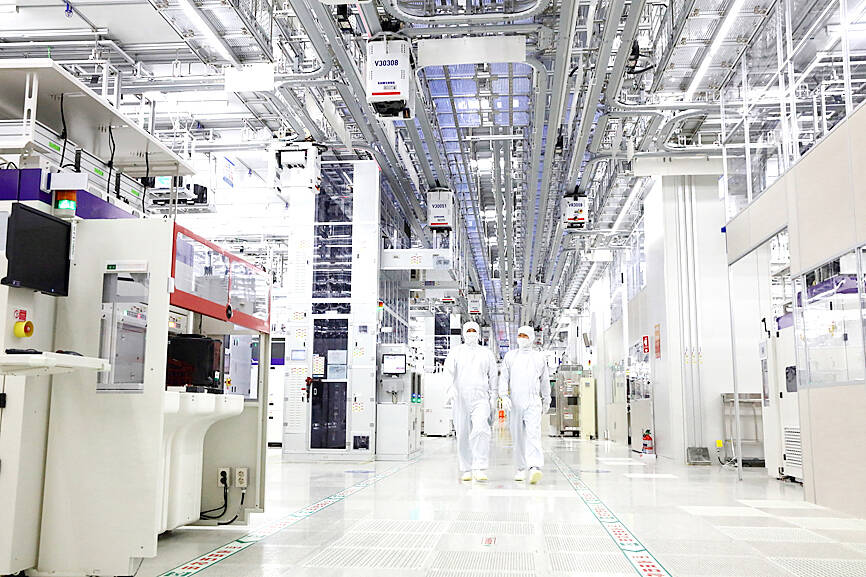A chip plant that South Korea’s Samsung Electronics Co is building in Taylor, Texas, would cost the world’s biggest memorychip maker more than US$25 billion, up more than US$8 billion from initial forecasts, three people familiar with the matter said.
The increase in cost is primarily due to inflation, the people said, declining to be named because the information is not public.
“The higher construction cost is about 80 percent of the cost increase,” one of the sources said. “The materials have gotten more expensive.”

Photo: Reuters
“The newly estimated cost could go up even more if the construction of the Taylor plant gets delayed,” a second source said, adding that the estimate could be fluid.
“The later the plant is completed, the higher cost we would be looking at,” they said.
Samsung did not immediately respond to a request for comment.
Chipmakers are applying for billions of US dollars in grants from US President Joe Biden’s administration through the Creating Helpful Incentives to Produce Semiconductors (CHIPS) and Science Act, aimed at ramping up chip production in the US.
However, increasing costs raise questions about how far those dollars will go. The bill was proposed in 2020, before a historic run-up in inflation that US officials are still working to tame.
Most US government grants would only cover up to 15 percent of the cost of new plants, US Department of Commerce officials said early this month.
In the three years since lawmakers first floated the US$52 billion figure for CHIPS Act grants, of which only US$39 billion is earmarked for direct investment in plant construction, the cost of labor has risen sharply, along with the price of construction materials such as steel.
That could push up the cost of what are already huge spending plans.
Last year, Taiwan Semiconductor Manufacturing Co (台積電), the world’s largest contract chip manufacturer, announced it was more than tripling a planned investment in a new plant in Arizona to US$40 billion.
Intel Corp announced a US$20 billion chip factory in Ohio that could cost up to US$100 billion, while Micron Technology Inc last year said that it planned to invest up to US$100 billion over the next 20-plus years to build a computer chip factory complex in upstate New York.
Samsung, the world’s No. 2 contract chip manufacturer, announced its Taylor plant in 2021.
It aims to make advanced chips for functions such as artificial intelligence, 5G and mobile phones, and promises to create 2,000 high-tech jobs.
Unlike some of its rivals, Samsung has already broken ground.
The company is rushing to finish the plant by next year so it can produce chips by 2025, which would put the company ahead of a 2026 deadline to secure investment tax credits on tools for the factory, one of the sources said.
Samsung has already spent as much as half of the US$17 billion initially projected for the Taylor site, two of the sources said.

The DBS Foundation yesterday announced the launch of two flagship programs, “Silver Motion” and “Happier Caregiver, Healthier Seniors,” in partnership with CCILU Ltd, Hondao Senior Citizens’ Welfare Foundation and the Garden of Hope Foundation to help Taiwan face the challenges of a rapidly aging population. The foundation said it would invest S$4.91 million (US$3.8 million) over three years to foster inclusion and resilience in an aging society. “Aging may bring challenges, but it also brings opportunities. With many Asian markets rapidly becoming super-aged, the DBS Foundation is working with a regional ecosystem of like-minded partners across the private, public and people sectors

BREAKTHROUGH TECH: Powertech expects its fan-out PLP system to become mainstream, saying it can offer three-times greater production throughput Chip packaging service provider Powertech Technology Inc (力成科技) plans to more than double its capital expenditures next year to more than NT$40 billion (US$1.31 billion) as demand for its new panel-level packaging (PLP) technology, primarily used in chips for artificial intelligence (AI) applications, has greatly exceeded what it can supply. A significant portion of the budget, about US$1 billion, would be earmarked for fan-out PLP technology, Powertech told investors yesterday. Its heavy investment in fan-out PLP technology over the past 10 years is expected to bear fruit in 2027 after the technology enters volume production, it said, adding that the tech would

YEAR-END BOOST: The holiday shopping season in the US and Europe, combined with rising demand for AI applications, is expected to drive exports to a new high, the NDC said Taiwan’s business climate monitor improved last month, transitioning from steady growth for the first time in five months, as robust global demand for artificial intelligence (AI) products and new iPhone shipments boosted exports and corporate sales, the National Development Council (NDC) said yesterday. The council uses a five-color system to measure the nation’s economic state, with “green” indicating steady growth, “red” suggesting a boom and “blue” reflecting a recession. “Yellow-red” and “yellow-blue” suggest a transition to a stronger or weaker condition. The total score of the monitor’s composite index rose to 35 points from a revised 31 in August, ending a four-month

RUN IT BACK: A succesful first project working with hyperscalers to design chips encouraged MediaTek to start a second project, aiming to hit stride in 2028 MediaTek Inc (聯發科), the world’s biggest smartphone chip supplier, yesterday said it is engaging a second hyperscaler to help design artificial intelligence (AI) accelerators used in data centers following a similar project expected to generate revenue streams soon. The first AI accelerator project is to bring in US$1 billion revenue next year and several billion US dollars more in 2027, MediaTek chief executive officer Rick Tsai (蔡力行) told a virtual investor conference yesterday. The second AI accelerator project is expected to contribute to revenue beginning in 2028, Tsai said. MediaTek yesterday raised its revenue forecast for the global AI accelerator used